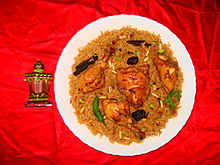


Omani cuisine is part of the Khaleeji cuisine and is influenced by Arab, Pakistani cuisine, Iranian, Indian, Asian, Eastern Mediterranean, and African cuisine,[1] reflecting Oman's position as a vast trading empire at the intersection of traditional spice trade routes.[2] Dishes are often based on chicken, fish, and lamb, as well as the staple of rice. Most Omani dishes tend to contain a rich mixture of spices, herbs, and marinades.[3] Omani cuisine differs from other cuisines in the Arabian peninsula, as it is less spicy and seldom served warm.[4]
Pork consumption is forbidden to Muslims in Oman, in accordance with Sharia, the Islamic law.
Although Omani cuisine varies within different regions of Oman, most dishes across the country have a staple of curry, cooked meat, rice, and vegetables. Soups are also common and are usually made from chicken, lamb, and vegetables (e.g. smoked eggplant). The main meal is usually eaten in the middle of the day, while dinner is lighter.

Tea is the national beverage, while coffee is drunk for hospitality. Other popular beverages include laban (a type of salty buttermilk), yogurt drinks, soft drinks, and Omani kahwa (coffee).
|
| |
|---|---|
| Sovereign states |
|
States with limited |
|
Dependencies and |
|
| Authority control databases: National |
|
|---|